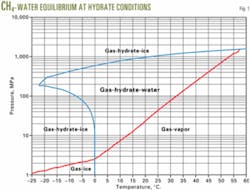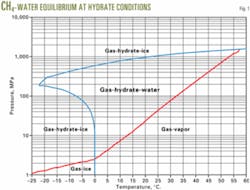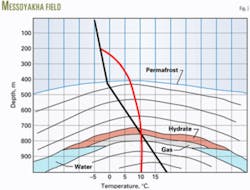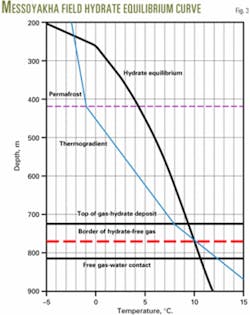Russian field illustrates gas-hydrate production
GAS-HYDRATE PRODUCTION—1
An examination of Messoyakha field, an onshore gas field in Russia, and the Blake Ridge area, in the Atlantic Ocean off South Carolina, provides a basis for estimating possible scenarios for future gas production from natural gas-hydrate deposits.
In this two-part series on gas-hydrate production, Part 1 examines the lessons learned in the Messoyakha field, while the concluding part will cover the potential for producing gas from gas hydrates in offshore areas such as the Blake Ridge.
Messoyakha field produces gas from the gas-hydrate zone through depressurization that turns the methane in hydrate form into free gas. Depressurization such as at Messoyakha only works when conditions in the gas-hydrate zone are at or near the pressure-temperature equilibrium boundary.
Costs to produce gas from onshore gas-hydrate zones when depressurization works should be about 10-15% higher than from conventional reservoirs in the same geographical area. This higher cost mainly results from the need to inject methanol into wells, pipelines, and facilities.
For offshore deposits where the pressure and temperature in the gas-hydrate deposits are not near the pressure-temperature equilibrium line, depressurization will not produce the gas from the hydrate layers. The only method that might work is thermal heating.
Thermal heating only is possible for thick hydrate layers that do not have large rock volumes between the hydrate layers that have to be heated.
Under ideal conditions, one could expect to produce 40-50% of the gas-in-place (in the area drained by producing wells) from deepwater gas-hydrate zones that contain thick, continuous hydrate layers
If the gas hydrate is dispersed widely either vertically or laterally, economic production may not be possible with any method.
Gas-hydrate deposits
Natural gas hydrate is a metastable mineral composed of gas and water. These hydrates are commonly formed from natural gas and seawater.
Gas hydrates can exist in a wide range of pressures and temperatures. For example, methane hydrate can exist both in a space-like deep vacuum (2.9 X 10–3 psi and –236° C.) and at high pressures (163,000 psi and 57° C.). Fig. 1 shows a portion of a general pressure-vs.-temperature phase diagram for methane hydrate.
Gas hydrates in nature were discovered in the 1960s.1-3 The State Register of the USSR recorded the scientific discovery of natural gas hydrates in 1969 after a thorough international examination of experimental results and industrial testing.4
Natural gas hydrate might become an important energy resource during this century, but the industry must first solve many problems associated with producing these deposits.
Production requires the development of new technologies as well as methods for forecasting possible tectonic cataclysms in gas-hydrate regions. Every country or company that wants to produce gas-hydrate deposits will have to address these problems. But it is hoped that cooperative research among industry, government, and academia will lead to technology breakthroughs.
Gas-hydrate deposits exist in the cold sections of sedimentary rock. On land, these deposits are in permafrost areas at 0–2 km depths. Offshore, the deposits are in sediments at 500–700 m depths below the mudline and at water depths greater than 300 m. Table 1 presents data from literature for 17 offshore gas-hydrate deposits in 1-5 km of water.
The environmental and reservoir properties of gas hydrates on land can differ substantially from those in deep water. Because of this, technologies for producing gas hydrates onshore will differ from those required for developing offshore deposits.
Data from Messoyakha field and the Blake Ridge area provide the basis for explaining a method for estimating possible gas recoveries under different conditions.
Messoyakha is the first and only gas-hydrate deposit with commercial gas flow rates. The Blake Ridge area, under study for about 20 years, has gas-hydrate samples and data from 11 wells that penetrated the gas-hydrate layers.
Estimates place the potential gas-in-place in Blake Ridge at 1,300 tcf in hydrate form and 681 tcf in free gas.5 To estimate a potential recovery factor for this gas, one needs to understand both the geologic and the thermodynamic characteristics of all formation layers containing gas hydrates. This includes the properties of formation layers lying between the gas-hydrate layers.
Three possible well-documented methods to unlock and produce the gas trapped in gas-hydrate deposits are:2-4
1.Reduce reservoir pressure below the hydrate-equilibrium pressure.
2.Increase reservoir temperature above the hydrate-equilibrium temperature.
3.Inject chemicals into the gas-hydrate layer that will cause dissociation.
From our analyses of gas hydrates under a variety of field conditions, we have determined that depressurization is only practical for a few gas-hydrate deposits because of the large drawdown required to reduce the reservoir pressure below the hydrate-equilibrium pressure.
Some deposits in arctic regions that contain substantial free gas below the gas hydrates may produce with depressurization. But depressurization is not feasible if the free-gas leg is nonexistent or small.
Chemical injection also is not feasible, in our opinion, because of the high cost of chemicals and the need to control where the chemical goes. Chemical injection methods require substantial further research, but for now, we believe the process will remain uneconomic.
The most sensible method for producing gas hydrates in deep water or when no free-gas leg exists is to increase the temperature of the gas hydrates. Literature suggests many methods for this, but it is clear that substantial research in both the laboratory and the field is still needed to determine the most economic heating methods.
Messoyakha field
Messoyakha field, discovered in 1967, is in the northwestern portion of East Siberia (68.5-68.7° North latitude and 84-85° West longitude). This transarctic region is almost inaccessible and lies on the west side of the Yenisey River.
Production started on Jan. 8, 1970, and the field played an important role for the economic development of the region. The field initially produced up to about 200 MMscfd.
A 263 km, 20-in. pipeline transports the gas to Norilsk. The gas replaced bituminous coal in the region for heat and electricity generation. Currently, natural gas has replaced 97% of the bituminous coal previously used.
Messoyakha field is the first documented case of gas production from hydrates.
Messoyakha is a moderate-size field in Siberia and has unique characteristics. The field has a gas-hydrate layer that has trapped a significant volume of free gas below the hydrate zone. During the recent past (in terms of geologic time), the phase state of a portion of the methane often has changed between free gas and hydrate as pressure and temperature changed in the region.
About 2,000 years ago, the permafrost thickness in the region exceeded 540 m, and the current Messoyakha reservoir layer was completely in a solid hydrate (frozen) state. Oil and water were in direct contact with solid hydrate and the reservoir had no free gas.
With increases in reservoir temperature, the deeper gas-hydrate layers dissociated and formed free gas. Currently, the layers exist in the final stage of transformation from a hydrate to a free-gas state. Free-gas production combined with a decline in the reservoir pressure below the hydrate equilibrium pressure has contributed to the acceleration of the process for transforming the gas hydrate into the free-gas state.
The Messoyakha field has produced gas almost continuously from the hydrate since 1970. Thus, this field can serve as an analog for other such arctic onshore gas-hydrate deposits.
Messoyakha field initial held 848 bcf of free gas (without accounting for the presence of hydrate). The estimated producible reserves of gas in the hydrated state were 424 bcf, a meaningful quantity if it could be produced economically.
Geology
Messoyakha field is in a region that experiences large temperature variations during the year. The lowest temperatures reach in January is –55° C. with the average for the month of –28° C. Average temperature in July is 10° C., while the average annual temperature is –18° C.
The field has a 420-480 m thick permafrost zone. Cyclic supercooling of the gas-hydrate deposits contributed to the active process of hydrates forming and dissociating with time, which then reduced the rock cementation in the productive part of the formation layers. Currently, the productive layers have a low rock strength that limits the maximum allowed drawdown pressure in the layers to 29-59 psi.
Fig. 2 shows a general cross-section of Messoyakha field, based on data from exploratory and producing wells. The field covers a 12.5 by 19 km area and has about an 84-m structural closure. The geological cross-section shows the sandy-argillaceous deposits of Middle Jurassic, Lower and Upper Cretaceous, and Paleocene age that are overlapped by Quaternary sediments.
The upper part of the Dolganskaya formation contains the gas hydrates. The gas-bearing zone has an average 76-m thickness, with the top at 730 m. The gas-water contact is at about 850 m.
Reservoir porosity ranges from 16 to 38%, with an average of 25%, and residual water saturation ranges from 29 to 50%, with an average of 40%. Permeability varies widely from several millidarcies to 1 darcy, with an average of 125 md. The reservoir had an initial 1,150-psi pressure.
The initial reservoir gas composition was 98.6% CH4, 0.1% C2H6, 0.1% C3H8, 0.5% CO2, and 0.7% N2. The reservoir has an extremely low water salinity that does not exceed 1.5%. This also confirms the presence of active hydrate decomposition in the deposit.
Field development
Fig. 3 shows a temperature profile of the Messoyakha deposit with a superimposed hydrate-equilibrium curve. The deposit has a hydrate-free-gas interface at the 10° C. isotherm. As shown in Figs. 2 and 3, the pay zone consists of two deposits: free gas below the interface and hydrate above the interface.
The preproduction geo- thermal gradient (GTG) was 4.2° C./100 m in the pay zone, 1° C./100 m in the permafrost zone, and 3.0° C./100 m below the permafrost zone. The temperature is 8° C. at the top of the deposit and 12° C. at the bottom of the deposit.
The significantly higher GTG in the pay zone than in the GTG in the overlying rock is evidence for active hydrate dissociation.
Layers containing gas hydrate represent almost 20% of the sediment thickness in the hydrate zone. The thermodynamic interface of the gas-hydrate and free-gas deposits is not an impenetrable lithologic barrier but a phase boundary. The hydrated layers are in thermodynamic equilibrium.
The hydrate saturation in the pore space at the initial stage was about 20%.
The maximum preproduction hydrate supercooling in the deposit did not exceed 2° C. at the top of the pay zone. The deposit's average supercooling was 1° C. This low supercooling allowed hydrate dissociation with a small decrease in reservoir pressure in the deposit and prevented hydrate formation during the drilling of wells, especially after the addition of calcium salts to the drilling mud.
The field was developed with traditional oil and gas drilling and completion technologies because the original pressure in the free-gas portion of the reservoir was essentially the same as the equilibrium pressure for the gas hydrate deposits,
Fig. 4 shows the gas production and the actual and calculated reservoir pressure for the active and prolonged shut-in periods in the field. As of Jan. 1, 2004, cumulative gas produced was 430 bcf, including 230 bcf produced from hydrate dissociation. This hydrate gas was produced as free gas from below the hydrate layer.
The average reservoir pressure decreased from 1,150 psi to 880 psi during the 33 years the field has been on production. If the field contained no hydrates, calculations indicated pressure would have decreased to 530 psi.
During the first years of production when the field produced at higher rates, the reservoir pressure decreased to 735 psi, which was 235 psi below the hydrate-equilibrium pressure, thus, resulting in active hydrate dissociated. This dissociation reduced the reservoir pressure decline rate.
In the shut in period, 1979-82, the hydrate dissociation continued and eventually restored the reservoir pressure to the 880-psi equilibrium pressure.
After production resumed in 1982, gas production never exceeded 14 bcf/year and reservoir pressure has remained essentially constant since 1982 because total gas production approximates the amount of gas entering the free-gas portion of the reservoir from hydrate dissociation.
Since 1982, the depth of the gas-water contact (GWC) has not changed. The fact that the GWC is not moving also is consistent with the concept that gas from the hydrates is recharging the free-gas reservoir. Currently, the field has seven producing and nine observation wells. Annual gas production is about 14 bcf/year.
The lifting cost for the Messoyakha gas is 15 to 20% higher than for other gas fields in that area because of the cost of methanol injection. Otherwise, the costs associated with producing gas from the GHD in Messoyakha does not differ much from that in other fields in this remote, arctic region of Russia.
References
1. Makogon, Y.F., "A Gas Hydrate Formation in the Gas Saturated Layers under Low Temperature," Gas Industry, No. 5, Moscow, 1965.
2. Makogon, Y.F., Peculiarities of a Gas-Field development in Permafrost, Moscow: Nedra, 1966.
3. Makogon, Y.F., Hydrates of Natural Gas. Moscow: Nedra, 1974; Tulsa: PennWell Co., 1981.
4. "Natural Gas Hydrates" Discovery No. 75, Scientific Discovery and Invention Moscow, State Register Bulletin of the USSR, 1969.
5. Collett, T.S., and Ladd, J., "Detection of Gas Hydrate with Downhole Logs and Assessment of Gas Hydrate Concentration on the Blake Ridge," Ocean Drilling Report, Vol. 164, 2000.
The authors
Yuri F. Makogon is a research engineer in the petroleum engineering department of Texas A&M University. He has more then 40 years of experience in education and research for the oil and gas industry and is an expert on gas hydrates. He previously worked in oil field operations, research, and education in the Ukraine and Russia. Makogan has a BS and MS in petroleum engineering from Moscow's Oil-Gas Gubkin Institute, and a PhD in petroleum engineering from Moscow's Central Gas Research Institute.
Stephen A. Holditch heads the petroleum engineering department at Texas A&M University. Previously he had his own oil field consulting company, S.A. Holditch & Associates, that became a part of Schlumberger Technology Corp. in 1997 and then was combined with other groups in Schlumberger to form Holditch Reservoir Technologies in 1999. Holditch has a BS, an MS, and a PhD in petroleum engineering from Texas A&M University. He was the 2002 SPE president and was elected to the US National Academy of Engineering (NAE) in 1995 and the Russian Academy of Natural Sciences in 1997.
Taras Y. Makogon works for BP America Inc. in areas of flow assurance and production chemistry. His work includes hydrate control, wax deposition, multiphase design, and economic evaluations. Makogan has an MBA from Houston Baptist University and a PhD from the Colorado School of Mines.








